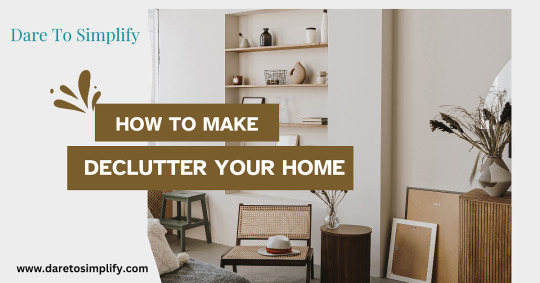#DeclutterfortheNewYear
Explore tagged Tumblr posts
Text
Dare to Simplify: The Best Decluttering Strategies and Tips for a Stress-Free Home
Decluttering your home isn’t just about making things look tidy; it’s about creating a space that promotes peace, productivity, and positivity. A clutter-free home is a reflection of a clear and organized mind. However, many people find the process of decluttering overwhelming. This guide will break it down step by step, offering you the best decluttering strategies and tips to simplify your living space and improve your life.
Why Decluttering Matters
Clutter not only takes up physical space but also affects your mental well-being. Studies show that an organized environment can reduce stress, improve focus, and increase overall happiness. By decluttering, you’re not just cleaning your home—you’re simplifying your life.

The Best Decluttering Strategies
1. The “One Room at a Time” Approach
Focus on decluttering one room before moving on to the next. This prevents overwhelm and allows you to see progress quickly. Start with areas you use daily, like the kitchen or bedroom, to feel an immediate impact.
2. The Four-Box Method
Gather four boxes and label them: Keep, Donate, Sell, and Trash. As you go through your items, place each one into the appropriate box. This method helps you make quick decisions and keeps the process organized.
3. The “20-Minute Rule”
Set a timer for 20 minutes and declutter as much as you can in that time. Short bursts of focused effort are less intimidating and easy to fit into a busy schedule.
4. The KonMari Method
Popularized by Marie Kondo, this method encourages you to keep only items that “spark joy.” Hold each item in your hands and ask yourself whether it adds value or happiness to your life.
5. Declutter by Categories
Instead of decluttering by room, try tackling specific categories like clothes, books, or kitchenware. This approach allows you to see how much of one type of item you own and make more mindful decisions.
Best Decluttering Tips
1. Start Small
Begin with small tasks like decluttering a drawer or a single shelf. Completing small projects motivates you to tackle larger areas.
2. Use the “One-Year Rule”
If you haven’t used or worn an item in the past year, it’s likely you won’t use it in the future. Let it go.
3. Adopt a Minimalist Mindset
Shift your focus to owning fewer, more meaningful items. Ask yourself, “Do I really need this?” before bringing new things into your home.
4. Digitize Where Possible
Reduce paper clutter by scanning important documents and keeping digital copies. Similarly, store photos and music digitally to save space.
5. Get the Family Involved
If you live with others, involve them in the decluttering process. Assign tasks to each member and make it a group activity to speed things up.
6. Donate Regularly
Establish a routine of donating unused items. This not only helps others but also keeps clutter from building up again.
7. Set Realistic Goals
Don’t expect to declutter your entire home in one day. Break it down into manageable tasks and celebrate small wins.
How to Maintain a Clutter-Free Home
Decluttering is just the first step; maintaining it requires consistent effort.
Adopt the “One In, One Out” Rule: For every new item you bring into your home, get rid of one.
Regular Check-Ins: Set aside time every few months to review and declutter your space.
Create Designated Spaces: Ensure every item has a specific place, making it easier to put things back after use.
Is Decluttering Good for Students?
Yes, absolutely! A clean and organized environment can enhance focus, reduce stress, and improve productivity—key factors for students. Decluttering a study area can help students concentrate better and stay motivated.
FAQs
Q1: How do I start decluttering if I’m overwhelmed? Start with a small area like a drawer or a single shelf. Use the Four-Box Method to organize items, and tackle one section at a time.
Q2: What should I do with items I’m unsure about? Set them aside in a “maybe” box. Revisit the box after a few weeks. If you didn’t miss or need the items, it’s safe to let them go.
Q3: How often should I declutter? Decluttering is an ongoing process. Aim to do a thorough declutter once or twice a year and smaller check-ins every few months.
Q4: What are the benefits of decluttering? Decluttering reduces stress, increases productivity, and creates a more pleasant living environment. It also saves time and energy spent searching for misplaced items.
Q5: How can I make decluttering fun? Play your favorite music, involve friends or family, and set challenges like decluttering a room in a set time. Reward yourself after completing a task.
Q6: What’s the difference between decluttering and organizing? Decluttering is the process of removing unnecessary items, while organizing involves arranging the remaining items in a functional way.
Q7: How do I avoid re-cluttering my space? Be mindful of your purchases and avoid impulse buying. Practice the “One In, One Out” rule to maintain balance.
Conclusion
Decluttering your home doesn’t have to be a daunting task. With the right strategies and tips, you can simplify your living space and enjoy the benefits of a clutter-free environment. Whether you’re a student, a busy professional, or just someone looking to simplify their life, these decluttering techniques will help you create a home that’s organized, peaceful, and stress-free.
Start small, stay consistent, and embrace the joy of living with less. Remember, decluttering isn’t just about cleaning—it’s about making space for what truly matters. Dare to simplify today!
#DeclutterYourHome#BestDeclutteringStrategies#BestDeclutteringTips#DeclutterfortheNewYear#Stepstodeclutteryourhome#DeclutteringChecklist#declutteringtipsforbeginners
1 note
·
View note